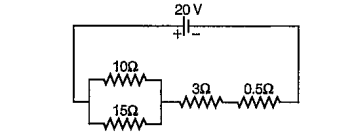(a) A current of flows in a series curcuit containing an electric lamp and a conductor of when connected to a battery. Calculate the resistance of the electric lamp.
(b) Now if a resistance of is connected in parallel with this series combination, what change (if any) in current flowing through conductor and potential difference across the lamp will take place ? Give reason.
(a) Total resistance in the circuit,
Since conductor of and lamp are in series,
pd across lamp
(ii) When resistance is connected in parallel with ,
total resistance in the circuit is given by
or .
Current through the circuit,
Since and are in parallel, current through
Thus, current through lamp and conductor of in series is i.e., there is no change in current through conductor of .
Further, pd across lamp , i.e., there is no change in pd across the lamp.
Topper's Solved these Questions
- ELECTRICITYBOOK - PRADEEPCHAPTER - ELECTRICITYEXERCISE - (Exemplar)Long Answer
6 Videos
- ELECTRICITYBOOK - PRADEEPCHAPTER - ELECTRICITYEXERCISE - (Additional)Very Short Answer
47 Videos
- ELECTRICITYBOOK - PRADEEPCHAPTER - ELECTRICITYEXERCISE - NCERT Exercise
18 Videos
- MAGNETIC EFFECTS OF ELECTRIC CURRENTBOOK - PRADEEPCHAPTER - MAGNETIC EFFECTS OF ELECTRIC CURRENTEXERCISE - Mock Test
21 Videos
Similar Questions
A current of 1 ampere flows in a series circuit having an electric lamp and a conductor of 5Ω when connected to a 10 V battery. Calculate the resistance of the electric lamp.
Now if a resistance of 10Ω is connected in parallel with this series combination, what change (if any) in current flowing through 5Ω conductor and potential difference across the lamp will take place? Give reason.
View SolutionNow if a resistance of 10Ω is connected in parallel with this series combination, what change (if any) in current flowing through 50 conductor and potential across the lamp will take place? Give reason.
View Solution
Knowledge Check
An inductor of 20 H and a resistance of 10Ω, are connected to battery of 5 volt in series, then initial rate of change of current is :-
A0.5amp/sB2.0amp/sC2.5amp/sD0.25amp/sThe current flowing through a lamp marked as 50 W and 250 V is
A5 ampB2.5ampC2 ampD0.2amp
As electric lamp and a conductor of resistance 4Ω are connected in series to a 6 V battery. The current drawn by the lamp is 0.25 A. Find the resistance of the electric lamp.
View SolutionIn the circuit, the current flowing through 10Ω resistance

View SolutionFind the resistance of a conductor if the electric current flowing through it is 0.35 A when the potential difference across it is 1.4 V.
View SolutionWhat would be the resistance of a conductor if the current flow through it is 0.35 A when the potential difference across is 1.4 V?
View SolutionA conductor of resistance 25Ω of diameter 0.2 mm is connected to a battery of 200 V . Calculate the current density for the conductor.
View SolutionThe resistance of two conductors in series is 40Ω and their resistance becomes 6.4Ω, when connected in parallel. Find the resistance of individual conductors.
View Solution
